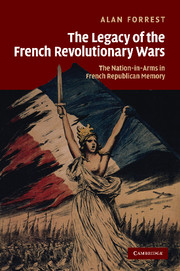Book contents
- Frontmatter
- Contents
- Acknowledgements
- 1 Introduction
- 2 Creating the legend
- 3 Napoleon and the blurring of memory
- 4 Voices from the past
- 5 The hollow years
- 6 The Franco-Prussian War
- 7 The army of the Third Republic
- 8 Educating the army
- 9 Educating the republic
- 10 The First World War
- 11 Last stirrings
- 12 Conclusion
- Bibliography
- Index
- Titles in the series
- Frontmatter
- Contents
- Acknowledgements
- 1 Introduction
- 2 Creating the legend
- 3 Napoleon and the blurring of memory
- 4 Voices from the past
- 5 The hollow years
- 6 The Franco-Prussian War
- 7 The army of the Third Republic
- 8 Educating the army
- 9 Educating the republic
- 10 The First World War
- 11 Last stirrings
- 12 Conclusion
- Bibliography
- Index
- Titles in the series
Summary
The role of nostalgia was crucial in keeping memories of the levée en masse alive in the years that followed Waterloo. References to the army of the Year II conjured up images of violence, political terror and regicide in royalist minds, as well as associations with the Napoleonic regime, and these, of course, were anathema to the new political rulers of France. They were anathema, too, to the Restoration Church, which, following Joseph de Maistre, denounced the Revolution as a form of divine punishment for the sins of the nation and urged that France could only avoid further punishment by ‘wiping out the crime that made it necessary, or by prayer’. With the blessing of the government, it sought to eradicate the ideological legacy of the Jacobins through an intensive campaign of missions to those regions of the country which the Catholic hierarchy, many newly returned from emigration, deemed to be especially decadent and in need of spiritual redemption. In particular there was concern that in areas that had been systematically dechristianised during the Revolution, church attendance was resumed more quickly than the practice of the sacraments. Memories of the Year II outraged opinion in those deeply divided regions of the country – like the west or the Rhône valley – where memories of terror and massacre were still vivid and where a resurgence of White Terror always threatened.
- Type
- Chapter
- Information
- The Legacy of the French Revolutionary WarsThe Nation-in-Arms in French Republican Memory, pp. 87 - 111Publisher: Cambridge University PressPrint publication year: 2009

